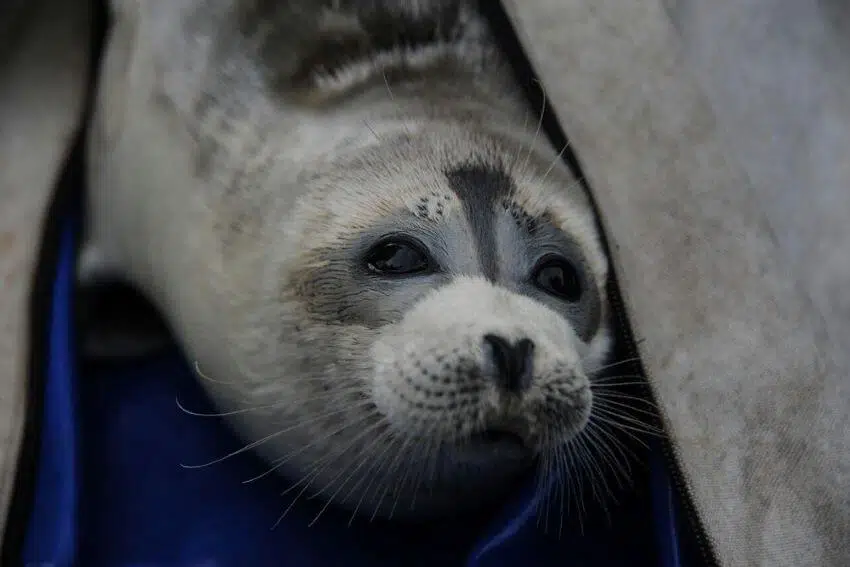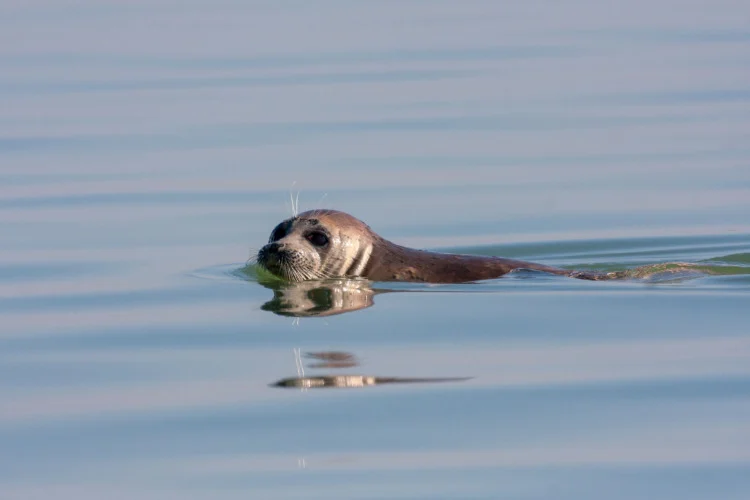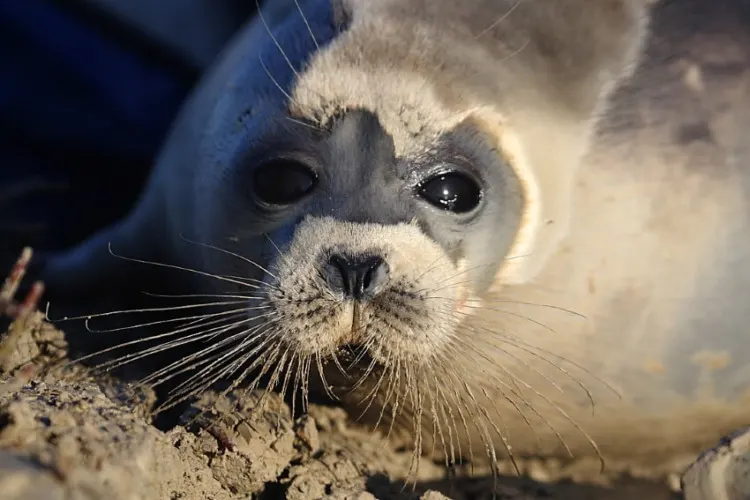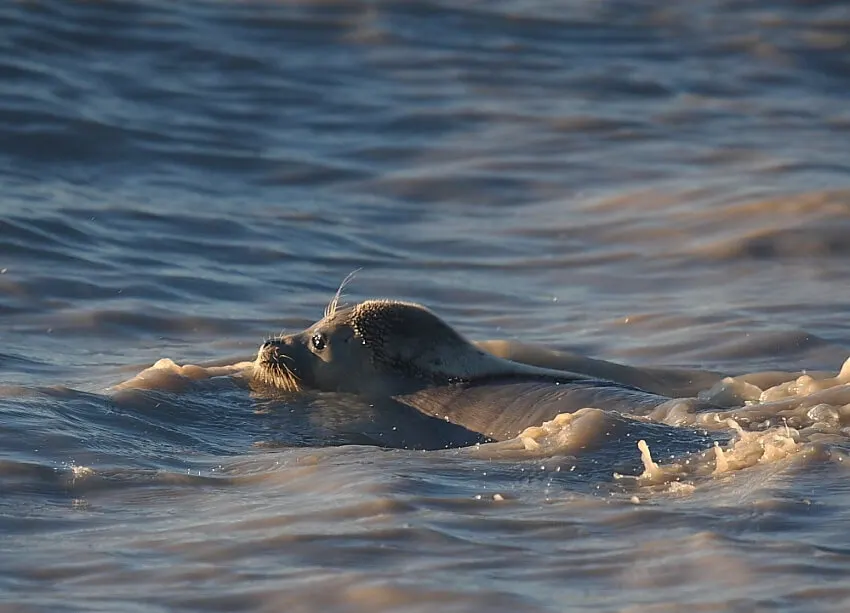The Caspian Seal is an endangered species native to the Caspian Sea. The seal has been hunted for centuries, and its population has dwindled. Many threats to the Caspian Seal’s survival include climate change, oil spills, and poaching.
- Status: Endangered
- Known as: Caspian Seal
- Estimated numbers left in the wild: Perhaps 76,000.
These animals are Caspian Seal endangered, as their population has declined significantly in recent years. Caspian seals are characterized by their black fur, which helps them blend in with the dark waters of the Caspian surrounding countries and sea.
Description

Anatomy and Appearance
The Caspian seal belongs to the earless seal group and can be counted as one of the smallest of these seals.
The male seal is a large creature that is somewhat larger than the female and can weigh up to 90 kilograms; the length of these seals is 1.4 meters for the females and 1.5 meters for the males.
Both sexes have medium to dark grey coats with darker splotches on the back, while the underside is slightly lighter in coloration.
Location
This seal is found exclusively in the Caspian Sea, surrounded by Russia, Kazakhstan, Iran, Azerbaijan, and Turkmenistan. The Caspian seal will sometimes travel up the empty rivers into the sea.
Caspian Seal Habitat
These marine mammals are endemic to the Caspian Sea. It is the only marine mammal living in this inland sea. The Caspian Seal’s habitat is mainly the Caspian shelf, where it can be found in water from 10 to 200 meters deep.
They are also occasionally seen near the mouths of rivers that empty into the Caspian Sea. The Caspian seals migrate and haul out on ice floes, land to rest, give birth on ice sheets, and mate.
Caspian Seal Diet and Nutrition
The diet and nutrition of the Caspian seal are not well known, but it is thought to be primarily a fish-eater.
The seals feed on fish, mainly carp species and shrimp. They are not fussy and appear to take advantage of whatever prey is available at the time.
These seals will often migrate within the confines of the Caspian Sea if food becomes scarce in any one area.
Caspian Seal Mating Habits

The Caspian Seal is a medium-sized, earless seal inhabits the Caspian Sea. Little is known about breeding seals’ mating habits, but it is believed that the breeding season is in late winter or early spring.
After around 11 months, female adult Caspian seals give birth to one or two pups. The pups are nursed for approximately four weeks. After which, they are weaned and begin to learn how to hunt and swim.
While these marine mammals use the entire extent of the sea during spring, summer, and the beginning of autumn, they will assemble in the northeastern region for the pupping season during late autumn.
The icing over the water signals the females to search for a suitable spot to give birth. They prefer to stay near open water and keep holes open in the ice to provide them with easy access for feeding.
The Caspian seal pup is born after an 11-month gestation period.
The pup is nursed by its mothers for about a month. Born with thick, white fur (lanugo) required for insulation, the baby Caspian seals molt into the waterproof grey coat of the adults after about a month.
Caspian Seal Role in the Ecosystems
These seals are vitally important to the health of the Caspian Sea ecosystem, and their loss could have serious consequences for the entire ecosystem.
Caspian Seals feed mainly on fish, and they help keep the fish population in check. They also play an essential role in nutrient cycling, and their excrement helps fertilize the Caspian Seafloor. These seals are also an important food source for other predators in the Caspian Sea ecosystem.
If the Caspian seal population continues to decline, it could have serious consequences for the Caspian Sea ecosystem.
The loss of these seals would mean fewer fish for other predators to eat, and it could also lead to an increase in the amount of pollution in the Caspian Sea. This is why protecting the seals and their habitat is so important.
Caspian Seal Predators
The Caspian seal is preyed upon by various predators, including orcas, sharks, and sea lions. They are also susceptible to becoming infected with harmful parasites, ultimately leading to seal deaths.
Relation with Humans
The seal is one of the most endangered seal species in the world. There are only around 600 Caspian seals left in the wild, and they are threatened by hunting, pollution, and climate change. Despite their endangered status, these seals have a surprisingly close relationship with humans.
The seal has been known to interact with humans. They have been known to approach boats and even jump onto them. They have also been known to follow fishermen around and play with their catch.
See Related: How Similar is Human DNA to Other Animals
Caspian Seal vs. Other Seals
Caspian seals are different from other seal species because they have a unique coloration. They are light gray or white with dark markings on their heads and tails. These seals live in the Caspian Sea and the Black Sea.
Other seal species include the harbor seal, grey seal, and ringed seal. These seals live in North America, Europe, and Asia. They are all dark brown or black with light fur on their chests. Harbor seals are the smallest of the three species.
They weigh about 150 pounds and measure about 5 feet long. Grey seals are the largest of the three species, which weigh about 350 pounds and measure about 7 feet long. Ringed seals are the middle-sized seal species and they weigh about 250 pounds and measure about 6 feet long.
Caspian Seal Facts
Here are the fun facts you need to know about Capsian seals.
- These seals are the smallest of the ice seals found in the Caspian Sea.
- These species have a life expectancy of around 25 years.
- These seals are excellent swimmers and can reach speeds of up to 10 km/hour.
- These seals use their whiskers to find prey hiding in cracks and crevices underwater.
- These species are the smallest of ice seals.
- They get their name from the Caspian Sea, where they live.
Conservation Status
The Caspian Seal is one of the most endangered seal species globally. There are only about 2500 left in the world.
Threats
The main threat to the Caspian seal has been a man. These seals were approximately 1.5 million at the end of the 19th Century, but constant over-hunting has sadly vastly reduced their population.
Hunting
These seals have been hunted for their meat and blubber, as well as for their skins. The fur market has especially coveted the white fur of the seal pups. The very low population of the seals put an end to wholesale hunting in 1960, although it was still permissible to kill newborn pups.
Predators
In addition to predation by man, the seals have been attacked both by wolves and sea eagles in the last few decades. In the 1970s, wolves killed up to 40% of the seals wantonly – the seals were not even eaten.
When the wolves eased up, the eagles rushed to fill the void and killed over 10% of the Caspian seal pups.
Dichlorodiphenyltrichloroethane (DDT)
Open hunting and poaching are not the only threats these little seals face; however, DDT is still used in the Caspian countries, and the pesticide has been found in the tissues of the seals.
DDT is believed to be responsible for diminished fertility in female seals, with many unable to conceive.
An epidemic of canine distemper has also scourged the seal in recent years. Once again, it is believed that DDT is responsible; weakened immune systems leave the seals more susceptible to illness.
Canine Distemper Virus (CDV)
Canine distemper virus is a highly contagious virus affecting all dog breeds. These eals are one of the animals that are at risk for contracting the virus. The virus is believed to be responsible for the death of many infected seals.
Food Shortage
Overfishing has also depleted some of the fish species that seals feed upon.
Climate Change
Climate change has been a significant threat to Caspian seals. The seal is one of the most endangered animals globally, and climate change is the main reason for their decline.
As the climate changes, their habitat is becoming increasingly saline, making it difficult for the seal to survive.
Fishing Nets
Fishing nets affect the Caspian seal population because they often get caught in the nets, leading to injury or death.
Conservation efforts
Although lip service is given in the surrounding countries to preserve the seal species, it is still hunted legally and illegally, with enforcement spotty or non-existent.
NGOs are working now to monitor seal populations and raise awareness of the animals’ plight. It is hoped that reserves will be established to offer the seals better protection and that a complete ban on hunting will be instituted.
Darwin Caspian Seal Project
The Caspian Seal Darwin Project is a research project that investigates the Caspian seal and its potential to become a new model for the study of animal evolution.
The seal species is an interesting species because it is the only species of seal in the world that can live in both salt and fresh water.
See Related: Best Conservation Posters
Organizations
Do you know of or are you a part of an organization that works to conserve the Caspian Seal? Then please contact us to have it featured on Our Endangered World.
World Wildlife Fund
The Caspian Seal is one of the most critically endangered species globally. The WWF has been working tirelessly to help with their conservation. The organization work with the local communities to help them understand and appreciate the importance of the seals.
As well as restoring damaged habitats, creating artificial ice breeding grounds, and providing food and medical care for the seals.
See Related: Why We Should Care About Climate Change
Final Thoughts

Caspian seals are one of the most endangered seal species in the world. They have been hunted for their meat and blubber and skins throughout history because they were so plentiful. Today there are only about 2500 left in the world.
They also have a very low birth rate. Female Caspian seals often cannot conceive because of the high levels of DDT in their system. The Caspian Sea is also threatened by predators, such as wolves and sea eagles, and by becoming trapped in nets meant for other fish.
You can help the Caspian Seal by donating to or volunteering for organizations such as the WWF to help conserve this species. You can also help by spreading the word about the seal and its plight.
FAQ
Is Caspian Seal endangered?
Caspian seals are listed as endangered by CITES. CITES is an international agreement between 114 countries to ensure that trade in wild animals and plants does not threaten their survival.
Why is the Caspian seal endangered?
Caspian seals face several threats, including that population has declined due to poaching for meat, skin, fat, and oil; the ongoing pollution of rivers with industrial waste and chemicals; and disturbance from oil and gas exploration activities.
They are particularly vulnerable because there are so few of them, and they only live in one place.
Are Caspian seals aggressive?
Caspian seals are generally relatively gentle, and a Caspian seal bite is not usually fatal. There are a few reasons why these marine species can become aggressive.
One reason is when they defend their territory by making flipper waving gestures and fierce snorts. Another reason is when they are protecting their young. They can also be aggressive when they are hungry or sick.
How many Caspian seals are left in the world?
Approximately 100,000 Caspian seals remain in the world. It is a species of pinniped that resides in the Caspian Sea.
What can people do to help Caspian Seals?
People can do a lot to help Caspian Seals. Some ways are to reduce hunting, stop polluting their habitat, and create protected areas.
Other Species Profile
Related Resources


